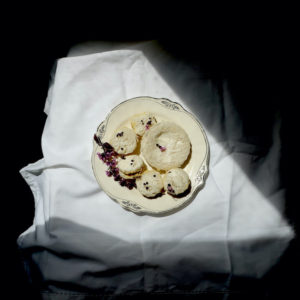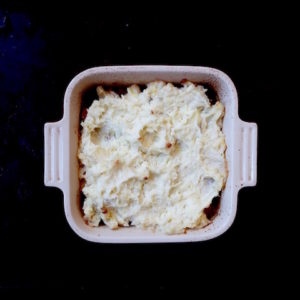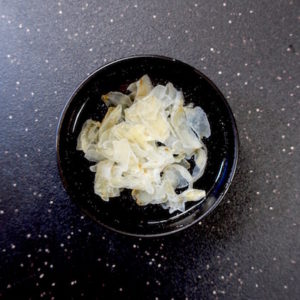Dorothy Allhusen’s Potted Beef
As the world grows increasingly disorderly, I find myself seeking refuge in the past.
By “the past,” I mean cookbooks. I don’t have a time machine.
Let us turn to Britain between the wars.

Built during World War II, but not in Britain. Shot several years ago.
—
It is easy, and erroneous, to assume the past a better place. By most measures it was not. Life in the British upper classes was wonderful for the few while being wholly oppressive for the many. Servants employed in Britain’s finest country houses may have escaped poverty, but having been a housecleaner myself, I can attest to the field’s occupational hazards. Inhaling powdered cleansers gave me a chronic cough. Scrubbing, lifting, bending, vaccumming, and mopping left me exhausted, aching, and constantly hungry.
All to say, I may seek refuge in older works, but that escapism isn’t all scones and cottagecore. To read Dorothy Allhusen’s A Book of Scents and Dishes is to encounter cringeworthy passages of Xenophbia and sexism. Yet we must recall Mrs. Allhusen, born in 1877, was very much a product of her era, just was we are of ours. We can no more expect her to be “woke” than we can be expected to go barefaced on the bus.

I have taken this photo at least six hundred times. Okay, maybe that’s a stretch. But still. Why won’t it work?!
—
Potted beef is England’s answer to rillettes. Traditionally served at breakfast, potted beef was eaten with hot toast. Interested readers may find an in-depth discussion of British potted dishes in Elizabeth David’s An Omelette and A Glass of Wine. For a discussion of potted dishes and their role on the Christmas table, see Elizabeth David’s Christmas, edited by Jill Norman.

As a self-taught American born in the late 1960’s, I claim no expertise whatsoever on rillettes or potted beef. This said, the biggest difference I see is rillettes depend on either duck or pork fat for their preserving qualities while potted beef relies on clarified butter.

It also appears that where the French family of preserved foods–confits, rillettes, rillons, etc–are intended to keep for months, English potted foods are intended to last for a few weeks.
—
Mrs. Allhusen’s recipe for potted beef is vague at best. She assumed an audience that either knew how to cook or had cooks who did. That people might attempt her recipes nearly a century later likely never occurred to her.

Hence instructions for mace “the thickness of a florin” and a “breakfastcupful” of water. I myself have never seen a florin. Never mind. The basic idea is there.
A few pointers on potting your beef:
You will be eating potted beef at cool room temperature, so season rather highly.

We discuss these custard cups further on down the post, so to speak, but the pictures came out nicely, so here’s one early on. If you’re American, you should be getting accustomed to disparities like this by now.

Your potted beef will throw off a lot of broth while cooking. This broth is delicous, but you cannot pour it into your potted beef, as it negatively affects keeping time. Freeze the broth, or use it to make soup, or add it to anything in need of liquid: rice, barley, lentils, steak.

No broth pictures. Here’s a pumpkin. Not that the kids can trick or treat. Poor things. When I was wee thing, we worried about Halloween being snowed out. Snow! Now there’s no snow and kids are trapped indoors due to pandemic. What a world.

Anyway. Potted beef. This is the steak I used–inexpensive stuff–and the size I cut it to. Not a great photo, but a practical one.

Cook the beef in a pot that’s deep rather than wide. Ceramic, clay, or eathernware are ideal, but use whatever you’ve got. Nobody will be stopping in to conduct an inspection. Whatever you use, use just enough water to cover the beef. Do not swamp.

Much as many of us long for the vintage French rillette pots sold on Etsy (there’s only one left and it’s in four people’s carts! Isn’t that feature annoying?) we must settle for the more prosaic items found on our cupboard shelves. Our own dull stuff may garner less Instalikes, but they work just fine. (Read: you don’t need to buy! buy! buy! and get likes! likes! likes!)

Cover the top of each pot, or dish, or whatever, with a thick layer of clarified butter. This keeps air out. If you really want to push to boat out, use clarified butter and add a thin layer of duck fat or lard atop that. At times like this, we take our pleasures where we can get them.

While potted beef may be kept in a cool basement or larder, such places are increasingly scarce. Unless you live in Iceland, refrigerate your potted items. Do not get sick and sue me. You have been warned.

Be careful when refrigerating your freshly potted beef. While placing mine in the refrigerator, I spilled one, sending melted butter across the cool refrigerator shelf. Of course, it immediately began setting. Should this happen to you, white vinegar is helpful. Though smelly, it’s actually edible, so you won’t poison anyone whilst cleaning up.

Potted Beef
Please read notes before cooking
adapted from Dorothy Allhusen’s recipe for potted steak in A Book of Scents and Dishes
Yield: 14 ounces/400g yielded 6 ramekins. The ramekins were 5 ounces/125 ml each. Feel free to scale up or down
Prep time: The meat took about 70 minutes in a low oven. Potting it took another half hour or so.
You will need kitchen muslin and either a small food processor or mortar and pestle for this recipe.
approximately 1 pound/16/ounces/454 grams lean beef: flank, rump steak, or something comparable (I had 14 ounces/400g)
one pound/16 ounces/454 grams sweet butter
salt and pepper
Preheat the oven to 300F/150C
Cut the beef into small strips, as if stir-frying. Lay these in your cooking vessel, which should be deeper than wide. Salt and pepper the meat rather highly. Add enough water to just cover.
Cover loosely (foil is fine if your pan has no lid) and cook, checking after an hour. If the water level is really coming up, remove the lid. If the beef is cooking too quickly, and is nearing done but rather tough, turn heat down 25 degrees and let it cook another half hour or so. You want tenderness without coloring.
Cooking time should be 70-90 minutes total. Beef should be very tender.
While beef cooks, clarify butter.
Place butter in medium saucepan over low heat. Allow to melt, then cook. After about 15 minutes, the white milk solids will brown and rise to the top of the pan. Turn heat off. Let rest for a few minutes
Spread muslin across a strainer. Set strainer in bowl. Gently pour butter through strainer. The butter in the bowl is clarified.
When beef is tender, remove from oven and strain broth. Reserve for another use.
While beef cools, prepare six ramekins or one larger loaf pan to store the potted beef.
Beef may be minced with a mortar and pestle or with a food processor. I used a mini-processor. If you use the processor, take care to leave some texture.
Pound or process the beef, then spoon lightly into very clean pots, ramekins, or loaf pan, distributing contents evenly.
Pour butter over each evenly, ensuring tops are covered. Tap lightly on counter to clear any air bubbles. Cover with foil or plastic wrap. Cool for a few minutes, then refrigerate.
Delicous with bread, toast, mustard, and cornichons. Serve with green salad for a light meal.
Provided the beef is kept cold and covered, it should keep at least two weeks. Do not freeze.
Notes:
It’s hard to give amounts; I used 14 ounces/400g lean steak, and got six ramekins 5 oz/125 ml out of it. Initially I clarified 8 ounces/227g butter, but I ended up needing more. Better to have extra and use it elsewhere.
You can also finely chop the beef, if you have a large knife and a lot of patience.
You will be adding butter to the meat, so don’t use an overly fatty cut.
Jamie ain’t the only one crying.




